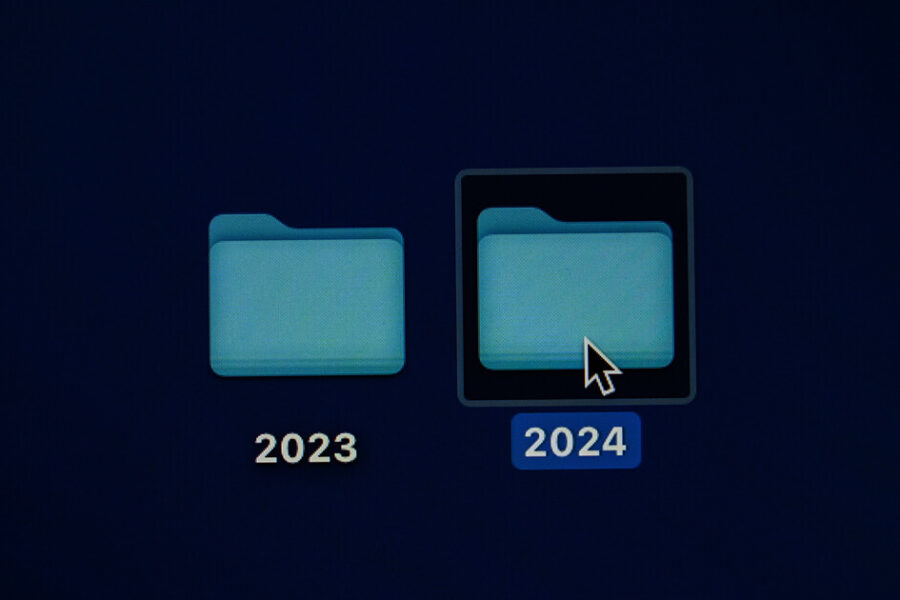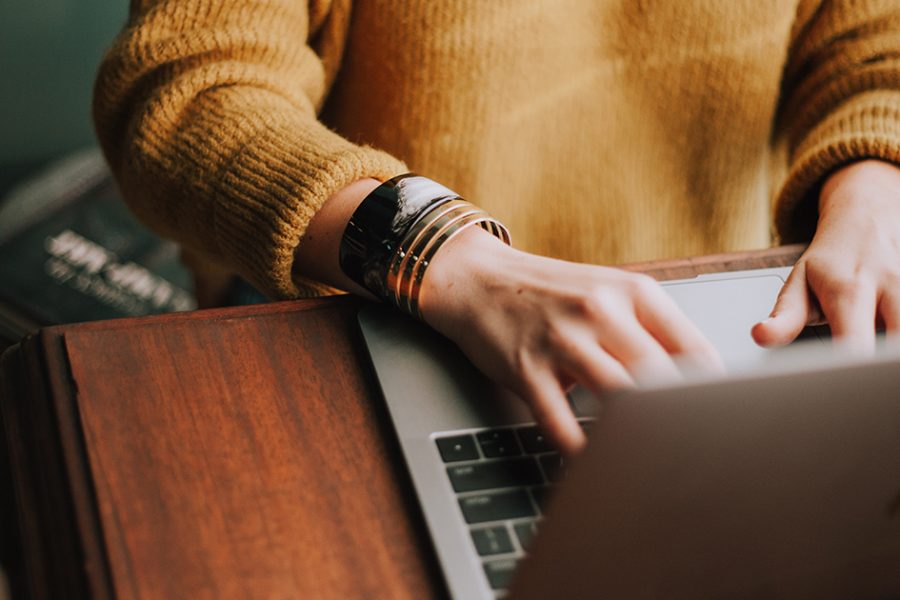As an industry that combines fast-moving technology with continually changing creative design, web design is constantly evolving. To stay current, your recruitment website needs to evolve too. A new year brings fresh ideas that fuse technological advancement with great design and there’s lots to look forward to.
RecWebs Designer Elizabeth Bennett shares what she’s excited about in the world of new web design developments for 2022:
At the moment I’m loving textures. Organic shapes and patterns can create a subtle feeling of texture across a design and I’m seeing lots of grainy gradients used in backgrounds and illustrations. Retro designs that feature gradient backgrounds, bright playful colours and visible borders will be on trend, as will blocky geometric shapes and big typography in the hero.
In contrast, spacious layouts, serifs and muted colour palettes will also feature heavily in 2022. Full screen abstract or nature-based background images with big bold typography that communicate a sense of the brand will continue to be used. We will see more movement as designers seek to take the user on a journey. Micro interactions and visual storytelling using animation and scroll effects will increase in popularity as design software evolves, encouraging more engagement with online spaces.
Elizabeth Bennet, RecWebs Web Designer
What are the design trends for 2022?
Web designers are looking both backwards and forwards as we move into 2022. The 90s are making a comeback (visually, not technologically!) but we’ll also see advanced experimental trends emerging. There are dozens of new web design trends pushing through so we’ve focused on the ones we are most excited about. Roll on 2022!
Retro nostalgia
Courier typeface, bright colour block backgrounds, primitive internet frames – the ‘90s are calling! The 90s are making a comeback across fashion and music so it was only natural that the decade should prove inspiration for web designers too. This is purely aesthetic nostalgia though and not a harkening to 90s technology. ‘90s vibes, 2022 tech. This is the opposite of the minimalist trend, incorporating bold colours, retro typography and Memphis design (inspired by the geometric shapes of the Art Deco movement, Pop Art colour palettes, and 1950 kitsch). Visible borders are also back. As well as adding to the retro 90s feel, they have the benefit of making the page easier to scan. Grainy gradients are also big, evoking a vintage vibe and providing a textural quality.
Earth tones
In direct contrast to the bright, colourful and quirky retro nostalgia trend, a more muted palette is proving popular amongst those who want to inject a feeling of calm into their website. Earth tones evoke a feeling of being outdoors, in nature – something that got many of us through lockdowns. The colours – used in illustrations and as background tones – are easier on the eye too, helping to keep your users on the page.
Organic shapes and patterns
Keeping with nature-inspired trends, organic shapes and patterns will overtake geometric shapes in 2022. Think anything that isn’t constrained or straight and unbending. Shapes and patterns that have fluidity and are unbound, like clouds floating across the sky, waves in the ocean, undulating hills. These can be background patterns or as an alternative way to break up sections and lend a softer, more organic feel to a website.
Micro interactions
Any design element that can be implemented to further engage your users is one that should be considered. Micro interactions are small animations that are triggered by either hovering your cursor over them or by scrolling to that part of the page. They draw users in, keep them on a page and are useful when communicating complex processes. Visual storytelling has been used since the dawn of mankind, it is an incredibly effective way to communicate a message, an idea, or a process. Micro-interactions are a quick, impactful way to do just that.
Oversized typography
Enlarging typography transforms words into design elements in their own right. This works particularly well in the hero, on top of, or even instead of, a hero image. Minimalist websites benefit from the impact it creates, where the typography becomes central to the design. Bold and experimental colours and fonts add to the impact. Used instead of any image, the words leap out of the page, grabbing attention and engaging the user.
Glassmorphism
Background buttons and frames are blurred in glassmorphism to create a glass-like effect, with clever plays on diffusion, shadow and reflection allowing the illusion of transparency. The UI blends into the background, creating the feeling of depth and immersion in the page, heightening the UX. Implemented well, the design can be sleek and ultra-contemporary but there is a warning attached to this trend. It can be easy to blend muted colours so much that the page becomes blurry and visual impact is affected. This can have an affect on accessibility, which is why neumorphism, a top trend for 2021, is now used far less.
Escapism
This is a trend that many will relate to in a year that’s followed such turbulent times. Think whimsical illustrations, unusual colours, fantastical settings – anything that transports the user into another world. Rich imagery is a big element and a way to bring this trend into your own websites, through background patterns or unusual icons. Take your website visitors somewhere else and inspire them.
Parametric designs
Parametric, or computational, design brings patterns to the forefront of the page, making a feature of them rather than keeping them in the background. Essentially, parametric design involves the manipulation of shapes and patterns to generate different geometric forms by adjusting the parameters of those shapes. The result? Visually striking, complex patterns that work well on websites that deal with technology or IT.
Collage graphics
Incorporating a range of different illustrations and photographs onto a page in a collage style adds an element of fun and a quirkiness to your website. It also allows you to play with a number of different relevant motifs rather than having a focus on one central image. Tie them together by adding a filter and arranging them in a seemingly random but repeating pattern.
3D design
Not a new design but one that is proving to have longevity, especially as the tech gets better and the design can be integrated more seamlessly. Importantly, screens are providing the resolution needed and broadband and mobile data speeds are faster. Eye-catching and immediately engaging, 3D designs bring the user into your website and create a real point of difference.
What’s out…
Neumorphism
One of the top web design trends for 2021, neumorphism has quickly fallen from grace. Why? It simply does not work from an accessibility viewpoint. The very reasons the style stands out – using light and shadow to create the feeling that components are emerging from the background – makes it hard to navigate and view for those with impaired vision, as well as situational vision difficulties such as the sun interfering with screen visibility. It’s a great example of style over functionality – accessibility has got to trump stylistic elements every time.
And what’s here to stay (forever)
Some things never go out of style and those are the elements that improve UX. The following aren’t technically trends as they should always be implemented. Every good recruitment website needs:
- Fast page speed load times
- Intuitive navigation
- Data security
- Mobile-friendly design
- Accessible, inclusive design
- Strong SEO
Web design is always in flux but that’s what makes it so exciting. The top trends are those that have longevity but continue to exude a contemporary feel. And of course there are some timeless elements that heighten UX and improve the user journey that will always be in style. The best recruitment websites are those that combine design flair with practical considerations.





